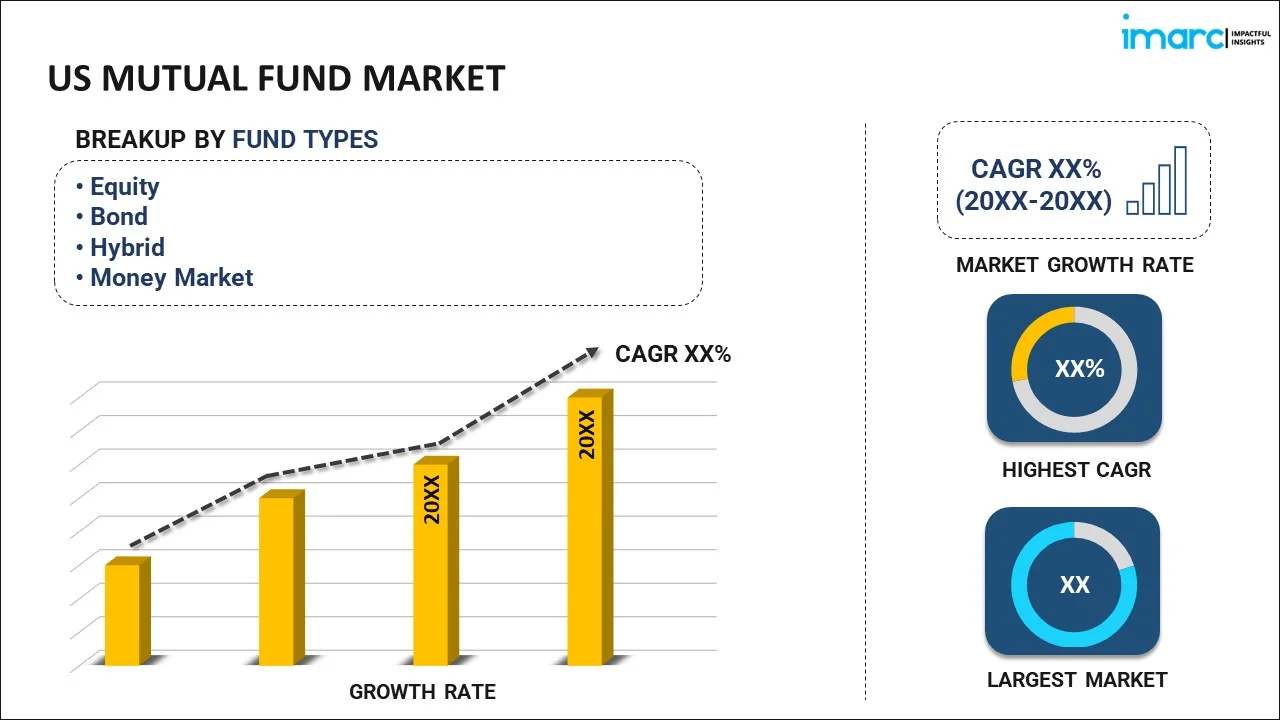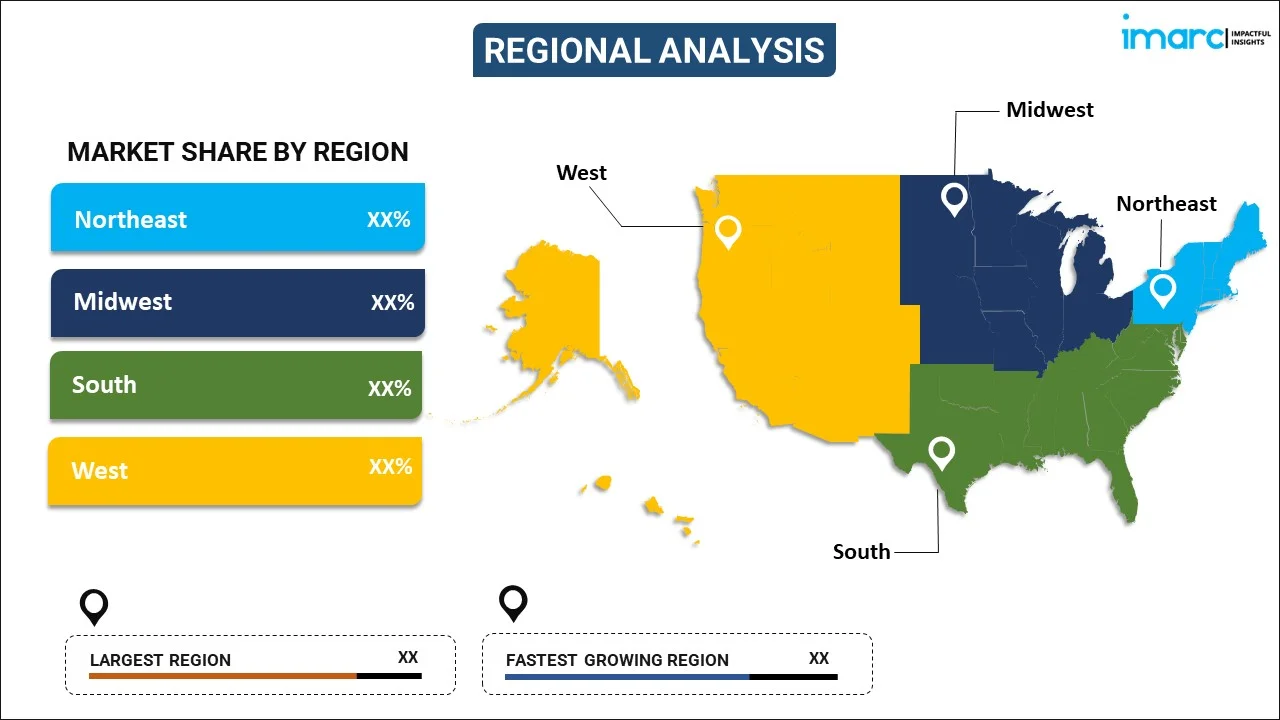
US Mutual Fund Market Report by Fund Type (Equity, Bond, Hybrid, Money Market), Investor Type (Households, Institutions), Channel of Purchase (Discount Broker/Mutual Fund Supermarket, Distributed Contribution Retirement Plan, Direct Sales From Mutual Fund Companies, Professional Financial Adviser), and Region 2025-2033
Market Overview:
US mutual fund market size reached USD 34.4 Billion in 2024. Looking forward, IMARC Group expects the market to reach USD 56.2 Billion by 2033, exhibiting a growth rate (CAGR) of 5.1% during 2025-2033. The increasing demand for online platforms, robo-advisors, and other innovations that can influence how investors access and manage their mutual fund investments, is primarily driving the US mutual fund market share.
|
Report Attribute
|
Key Statistics
|
|---|---|
|
Base Year
|
2024 |
|
Forecast Years
|
2025-2033
|
|
Historical Years
|
2019-2024
|
| Market Size in 2024 | USD 34.4 Billion |
| Market Forecast in 2033 | USD 56.2 Billion |
| Market Growth Rate (2025-2033) | 5.1% |
US Mutual Fund Market Analysis:
- Key Drivers: The increasing use of digital investment platforms and robo-advisory services is transforming investor access. Increased retirement planning consciousness among millennials is propelling higher participation. Regime-friendly regulation facilitating innovation in fund arrangements is accelerating market growth. Institutional investment and pension fund allocation are leading drivers of total market growth.
- Major Market Trends: Some of the key US mutual fund market trends are the technology-enabled personalized investment solutions are on the rise, with artificial intelligence boosting portfolio management. Sustainable and ESG-oriented funds are booming as environmental awareness accelerates. Target-date funds are increasingly popular among retirement savers. Fee compression prevails as competition increases among fund providers.
- Market Challenges: Increasing competition from cheap ETFs squeezes traditional mutual fund fee models. Compliance costs with regulations keep increasing, disproportionately affecting smaller fund managers. Volatility in the market impacts investor sentiment and fund performance. Demographic change presents long-term challenges with baby boomers moving towards distribution phases from accumulation phases.
- Market Opportunities: Based on the US mutual fund market analysis, the increasing international diversification creates new growth opportunities for fund managers. Integration of technology promises improved customer experience and process efficiency. Increasing financial literacy awareness demands professional management of investments. New alternative investment approaches create opportunity for differentiation.
A mutual fund is a pooled investment vehicle that collects money from multiple investors and professionally manages it by investing in a diversified portfolio of stocks, bonds, or other securities. Investors purchase shares in the mutual fund, and the fund's value is determined by the performance of its underlying assets. Mutual funds are managed by professional fund managers who make investment decisions based on the fund's objectives and strategy. This allows individual investors to access a diversified portfolio without the need for extensive market knowledge or large amounts of capital. Mutual funds provide a convenient way for investors to achieve diversification, liquidity, and professional management, making them a popular choice for those seeking a hands-off approach to investing in financial markets.
US Mutual Fund Market Trends:
Digital Transformation and Technology Adoption
The US mutual fund industry is undergoing record digital change, essentially redefining how investors engage with fund products. Automated investment platforms and robo-advisors are opening up access to high-level portfolio management that has been historically reserved for high-net-worth clients. Artificial intelligence and machine learning-based algorithms are improving fund selection processes, allowing for more accurate risk evaluation and customized investment advice. Mobile apps now give real-time portfolio tracking, transactional capabilities, and learning resources, making it easier for younger generations to invest in mutual funds. Blockchain technology is also being considered for enhancing transparency, shortening settlement times, and decreasing operational expenses. Digital onboarding procedures have facilitated account opening processes, while sophisticated analytics assist fund managers in making evidence-based investment choices. These technological innovations are not only streamlining operational effectiveness but also generating new revenue sources and competitive benefits for innovative fund companies.
Sustainable and ESG Investing Growth
Environmental, Social, and Governance (ESG) criteria are increasingly influencing mutual fund investment strategies, reflecting growing investor consciousness about sustainable investing. Climate change concerns are driving demand for funds that exclude fossil fuel investments or focus on renewable energy companies. Social responsibility factors, including labor practices, community impact, and diversity initiatives, are becoming standard evaluation metrics for fund managers. Corporate governance considerations, such as executive compensation transparency and board diversity, are gaining prominence in investment decision-making processes. Millennial and Generation Z investors particularly prioritize ESG factors, creating long-term structural demand for sustainable investment options. Regulatory bodies are implementing stricter disclosure requirements for ESG claims, ensuring greater transparency and authenticity in sustainable fund offerings. Performance data increasingly demonstrates that ESG-focused funds can deliver competitive returns while aligning with investor values, further accelerating adoption rates across all demographic segments.
Fee Compression and Value Innovation
Severe competition in the business of mutual funds is pushing deep cost compression across all categories of funds to the advantage of investors through lower costs. Index funds are squeezing actively managed funds into providing superior performance or distinctive value for paying higher expense ratios. Fund firms are competing by innovating new fee structures, such as performance-based fees and all-in-one advisory services that bundle investment management with planning. Technology is facilitating cost savings that permit companies to remain profitable in the face of reduced fees. Institutional investors are using their negotiating leverage to arrange lower fees for significant investments. Regulatory efforts encouraging fee disclosure are allowing investors to make more educated cost-sensitive choices. Emphasis on value-added offerings, like tax-loss harvesting, financial education, and tailored advice, is enabling fund companies to stand out based on anything other than investment outcomes and fees thus supporting the US mutual fund market growth.
US Mutual Fund Market Segmentation:
IMARC Group provides an analysis of the key trends in each segment of the market, along with forecasts at the country level for 2025-2033. Our report has categorized the market based on fund type, investor type, and channel of purchase.
Fund Type Insights:

To get more information on this market, Request Sample
- Equity
- Bond
- Hybrid
- Money Market
The report has provided a detailed breakup and analysis of the market based on the fund type. This includes equity, bond, hybrid, and money market.
Investor Type Insights:
- Households
- Institutions
A detailed breakup and analysis of the market based on the investor type have also been provided in the report. This includes households and institutions.
Channel of Purchase Insights:
- Discount Broker/Mutual Fund Supermarket
- Distributed Contribution Retirement Plan
- Direct Sales from Mutual Fund Companies
- Professional Financial Adviser
The report has provided a detailed breakup and analysis of the market based on the channel of purchase. This includes discount broker/mutual fund supermarket, distributed contribution retirement plan, direct sales from mutual fund companies, and professional financial adviser.
Regional Insights:

- Northeast
- Midwest
- South
- West
The report has also provided a comprehensive analysis of all the major regional markets, which include Northeast, Midwest, South, and West.
Competitive Landscape:
The market research report has also provided a comprehensive analysis of the competitive landscape in the market. Competitive analysis such as market structure, key player positioning, top winning strategies, competitive dashboard, and company evaluation quadrant has been covered in the report. Also, detailed profiles of all major companies have been provided.
Recent News and Development:
- In September 2025, Man Group launched its first standalone ETFs on the NYSE: the Man Active High Yield ETF (MHY) and Man Active Income ETF (MANI). MHY, managed by Mike Scott, focuses on high-yield securities, including small and medium issuers, aiming for income and growth. MANI, led by Jonathan Golan, invests in diverse debt instruments, using a bottom-up, opportunity-driven approach. These actively managed ETFs give US investors access to Man Group’s $42.7bn global credit platform and institutional-grade strategies.
- In June 2025, Stewart Investors launched its first U.S. mutual fund, the Stewart Investors Worldwide Leaders Fund (SWWLX), with initial backing from a U.S. foundation. Actively managed and benchmark-agnostic, the fund targets long-term growth by investing in 30–60 high-quality global companies focused on sustainable development. With a management fee of 0.45% and a capped expense ratio, SWWLX offers U.S. investors access to Stewart Investors’ established global equity strategy, previously available only to non-U.S. clients.
US Mutual Fund Market Report Coverage:
| Report Features | Details |
|---|---|
| Base Year of the Analysis | 2024 |
| Historical Period | 2019-2024 |
| Forecast Period | 2025-2033 |
| Units | Billion USD |
| Scope of the Report | Exploration of Historical Trends and Market Outlook, Industry Catalysts and Challenges, Segment-Wise Historical and Future Market Assessment:
|
| Fund Types Covered | Equity, Bond, Hybrid, Money Market |
| Investor Types Covered | Households, Institutions |
| Channel of Purchases Covered | Discount Broker/Mutual Fund Supermarket, Distributed Contribution Retirement Plan, Direct Sales From Mutual Fund Companies, Professional Financial Adviser |
| Regions Covered | Northeast, Midwest, South, West |
| Customization Scope | 10% Free Customization |
| Post-Sale Analyst Support | 10-12 Weeks |
| Delivery Format | PDF and Excel through Email (We can also provide the editable version of the report in PPT/Word format on special request) |
Key Benefits for Stakeholders:
- IMARC’s industry report offers a comprehensive quantitative analysis of various market segments, historical and current market trends, market forecasts, and dynamics of the US mutual fund market from 2019-2033.
- The research report provides the latest information on the market drivers, challenges, and opportunities in the US mutual fund market.
- Porter's five forces analysis assist stakeholders in assessing the impact of new entrants, competitive rivalry, supplier power, buyer power, and the threat of substitution. It helps stakeholders to analyze the level of competition within the US mutual fund industry and its attractiveness.
- Competitive landscape allows stakeholders to understand their competitive environment and provides an insight into the current positions of key players in the market.
Key Questions Answered in This Report
The mutual fund market in the US was valued at USD 34.4 Billion in 2024.
The US mutual fund market is projected to exhibit a CAGR of 5.1% during 2025-2033, reaching a value of USD 56.2 Billion by 2033.
The market growth is primarily driven by increasing demand for online platforms, robo-advisors, and technological innovations that enhance investor accessibility to mutual fund investments. Rising retirement planning awareness, favorable regulatory frameworks, growing institutional investments, and expanding adoption of digital investment solutions contribute significantly to sustained market expansion and development.
Need more help?
- Speak to our experienced analysts for insights on the current market scenarios.
- Include additional segments and countries to customize the report as per your requirement.
- Gain an unparalleled competitive advantage in your domain by understanding how to utilize the report and positively impacting your operations and revenue.
- For further assistance, please connect with our analysts.
 Request Customization
Request Customization
 Speak to an Analyst
Speak to an Analyst
 Request Brochure
Request Brochure
 Inquire Before Buying
Inquire Before Buying




.webp)




.webp)












